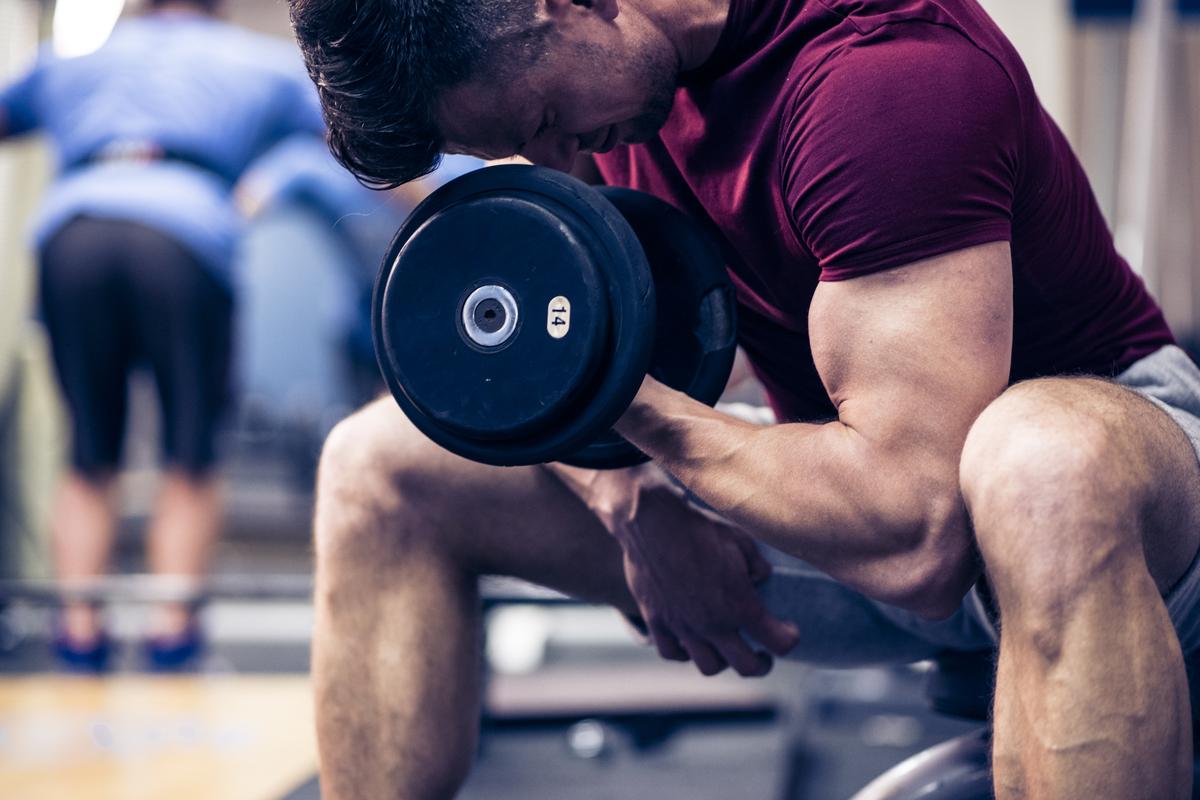Upper Body Dumbbell Workout | 8 Dumbbell Exercises To Target All Upper Body Muscles

Whether you’re completely new to this or no stranger to a heart-hammering session, these workouts are perfect for all levels of ability.
Bringing you this challenging upper body dumbbell workout at home, we have Reece Williamson. Using a super-effective combination of different exercises, we guarantee that you’ll be feeling this one in your biceps, triceps, shoulders, chest, and back. It really is the full package.
All you need for this upper body all-rounder is a single dumbbell or a pair of them (alternatively, try use something that you can easily hold with some weight to it from around your house if you have no dumbbells!).
If you're at the gym, then you can use a bench, although it’s not essential, as all of the exercises can be modified to use the floor instead.
This workout covers all the major muscle groups in the upper body, so here are a few things to remember:
Squeeze your muscles at the end of the concentric phase (when your muscles are shorting) — this helps develop the mind to muscle, or neuromuscular connection, which typically results in improved efficiency and strength when lifting in the future. Take advantage of a controlled eccentric phase (the lowering phase of a rep) — this increases the muscles time under tension, potentially causing more exercise-induced muscle damage. Your muscle fibres will be repaired bigger and stronger when optimal recovery strategies are employed.
Upper Body Dumbbell Workout | 8 Dumbbell Exercises to Target All Upper Body Muscles
You can gain a moderate amount of strength from this style of training, but the main aim is to increase muscle size — so it’s important to fatigue muscles until you reach (or get close to) failure.
The easiest way to achieve this, when you don't have access to those larger weights, is by increasing the number of reps, sets, and reducing rest periods to maintain the fatiguing stimulus.
If you only have access to lighter weights, ones where you can do over 20 reps comfortably, you can still reap the rewards by performing the concentric portion of the lift faster. This will encourage adaptations to muscle power, which is also beneficial for muscular strength and size.
Alternatively, you can slow down the movement during the eccentric to place additional stress on the muscle fibres, since they will need to support the load for a greater period of time as the muscle is lengthening.
Don't forget to warm-up
Any session needs a well-structured warm up. When done correctly, warm-ups promote blood flow to the target muscle groups, increasing the temperature of the muscles about to be used. This is important for reducing the risk of injuries such as muscle strains. By increasing the muscle’s temperature, you improve the ‘elasticity’ of their fibres.
Dynamic stretching might benefit you more, than static stretching, as research has identified that static stretching could be detrimental to power output. But, this depends on whether you want to improve your flexibility or the performance of your muscles.
Your warm-up should consist of general mobilisation drills, before focusing on more specific movements. That's doing the same exercises in your workout, but with a very lightweight — like benching pressing with an empty barbell, with incremental load increases before reaching the weight you're going to perform in your session.
1. Dumbbell Shoulder Press
Video reference: 1:15Targeted upper-body muscles: Deltoids, TricepsTechnique:
- This exercise can be done seated, standing or seated on the floor. Doing this exercise seated will provide more stability as you perform the exercise.
- The dumbbells should be held with your wrists stacked over your elbows, and the dumbbells at shoulder height. You can vary the grip position for this exercise, although you may find it more comfortable starting with a neutral grip (palms facing the side of your head), rotating to a pronated grip (palms facing away from you) as you press the weight to the top, or simply use a pronated grip throughout.
- To maintain proper form, pinch your shoulder blades together, tuck your elbows close to the body (in the start position), and allow your elbows to return to the start position at the end of each rep.
- While performing the exercise, be sure to drive the weight up with intent, squeezing your shoulder muscles at the top (as if you’re trying to push the weight further).
Reps:12-15
Tips: Keep your feet planted firmly on the floor to maintain stability, and brace your back to hold your spine in a neutral and strong position through the lift.
2. Supinated Grip Shoulder Row
Video reference: 2:01Targeted upper-body muscles: Biceps, Upper backTechnique:
- Lift the weight from the floor, before bending at the hips to reach the starting position. Maintain a neutral spine and hold the dumbbells with a supinated grip (palms facing away from your body).
- As you pull the dumbbells up during the concentric portion of the lift (muscles shortening), aim to tuck the weight towards your hip crease for preferential activation of the latissimus dorsi – the largest muscle in the upper body.
- Pulling your elbows directly towards the ceiling will result in more scapular retraction (using the muscles of the upper back), working smaller muscles – which are vital for strength and stability of the shoulder joint, so feel free to vary the position of the exercise. Return the weight to the start position in a controlled manner and repeat.
Reps:12-15Tips: Squeeze your shoulder blades together at the top of the movement to encourage greater neural activation of the muscle (mind to muscle connection). You can also take advantage of slow eccentrics (lowering of the weight) to maximise time under tension, and microtears to the muscle-fibres.
3. Chest Press / Dumbbell Bench Press
Video reference: 2:53Targeted upper-body muscles: Chest, Front deltoid, TricepsTechnique:
- Using a flat bench or simply use the floor if you don’t have access to a bench, start with your wrist stacked over your (extended) elbow, which should be stacked directly over your shoulder joint.
- You can use a neutral or pronated grip for this exercise. Brace your core muscles before lowering the weight, keeping your elbows tucked close to your body at approximately a 45- degree angle.
- Press the weight to the top position, squeezing your triceps, shoulders and chest muscles, before lowering for the next rep.
Reps:12-15Tips: Slowly lower the weight to maximise time under tension. Learn how to safely bail out of the movement prior to lifting the weight close to failure. Neglecting this may result in you bailing in an unsafe way which may result in a shoulder injury if you become too fatigued to safely lower the weights at the end of the set.
4. Rear Delt Flyes
Video reference: 3:53Targeted upper-body muscles: Upper back, Rear deltoidTechnique:
- Similar to the set-up of the bent-over row (you can do this exercise seated or standing bent-over), maintain a neutral back angle throughout each set. Your palms should be facing towards your body with a pronated grip.
- With a slight flex at the elbow, and the dumbbell held at around arms-length away, drive your elbows up towards the ceiling. Maintain a neutral and stable back angle, and squeeze at the top of the rep.
- It’s likely that you’ll need to use a lighter weight for this exercise, as there are fewer (and smaller) muscles being used, compared to the previous exercises on this list.
Reps:12-15Tips: If you’re finding it difficult to get to the top of the rep without jerking the weight around, try increasing the flexion angle at your elbow, resulting in the dumbbells being closer to your centre of mass throughout the movement – this will give you better leverage for lifting the weight efficiently.
5. Lateral Raise
Video reference: 4:49Targeted upper-body muscles: Lateral deltoidTechnique:
- This exercise can be done seated or standing and acts as an isolated movement for the lateral deltoid.
- Starting with holding the dumbbells in a neutral grip (palms facing towards the body) and with a slight bend at your elbows, lift the weight in a smooth arc away from the body sideways.
- Lift the dumbbell until it is level with your shoulder. Slowly lower the weight back to the start position in a controlled manner, again taking advantage of the time under tension during the eccentric lengthening of the muscles.
Reps:12-15Tips: Similarly to the rear deltoid fly, if you are finding it difficult to lift the weight (e.g. with a non- adjustable dumbbell), then you can adjust the amount of flexion at the elbow. A more extended arm will make the lift more difficult, while a more flexed elbow (weight closer to your centre of mass) will be easier.
Rotating the dumbbell either upwards or downwards at the top of the lift may give preferential activation to the upper of lower fibres, however, since it is such a small muscle, any variations should be down to your personal preference of what feels most comfortable.
6. Dumbbell Fly
Video reference: 5:44 Targeted upper-body muscles:ChestTechnique:
- Using a bench will allow you to achieve a greater range of movement for horizontal shoulder abduction (your hands will be able to go deeper than your shoulders at the bottom of the rep), which will result in a greater stretch of the fibres (i.e. more range to load eccentrically).
- While this may be good for some individuals, others may feel that their shoulder is more unstable around this position (particularly if you’ve suffered a dislocation in the past!), so it may be wiser do this exercise on the floor where your end range is limited by the floor.
- Start with the dumbbells above your chest in a neutral grip, slowly lowering them out to the side (you should feel quite the stretch on your chest muscles), before concentrically contracting your chest muscles to bring the weight back to the start position.
Reps: 12-15Tips: Squeeze (don’t slam!) the dumbbells together at the top of the rep to feel a stronger contraction in your chest muscles. Hold the contraction at the top of the rep for around 2 seconds before you start lowering the weights again.
7. Tricep Kickback
Video reference: 6:26Targeted upper-body muscles: TricepsTechnique:
- This exercise is unilateral (one side at a time), so you should support yourself by using the non-working arm with a bench or table. For the starting position, bend forward so that your torso is parallel to the floor.
- Tuck your elbow back so that your upper arm is also parallel to the floor, then moving only the forearm, ‘kick-back’ the dumbbell until your entire arm is parallel with the floor.
- This is the top position of the rep, so squeeze your triceps hard and try to hold it for around 2 seconds before slowly lowering the weight back to the start position in a controlled manner.
Reps:12-15Tips: Try not to move your elbow from the starting position, as if you let your elbow drop down, then some of the load will be taken off of the target muscle. Other that elbow extension, the triceps also extend the shoulder, so by maintaining the desired position throughout, you will allow the muscle to be able to shorten almost maximally, resulting in a better contraction.
8. Bicep Curl
Video reference: 7:19Targeted upper-body muscles: BicepsTechnique:
- Using a supinated grip (although you can also use neutral and pronated grips for preferential activation of different muscles throughout your arm), the starting position is with the dumbbells held with an extended arm down by your hips.
- Keep your elbows in the same position throughout the movement, ensuring you don’t swing and only flex at the elbow. You may find that you can use a similar weight to the tricep kickback, but don’t be afraid to play around with the weight if it’s too difficult or easy. Contract the muscle with intent at the top of the movement, before slowly lowering the weight.
- You can do this exercise either with both arms at the same time (bilateral), completing all of the reps on one arm first (unilateral) or alternate arms each rep, which you may find helps with fatigue (although remember we are trying to fatigue and overload the muscle!).
Reps:12-15Tips:
By keeping your elbows slightly forward ahead of your body, you will be holding your shoulder in a slightly more flexed position (another function of the biceps!), meaning that you will be able to reach terminal elbow extension without your torso blocking the path of the dumbbells (and thus a greater stretch on the biceps!).
You can play around with the amount of shoulder flexion present by doing the exercise in the same position at the bent over row, which will allow you to work your biceps through different portions of their range of movement (which is surprisingly big compared to other muscles!).
Remember to stretch after your workout
While the evidence base generally suggests that stretching after a workout does not influence delayed onset of muscle soreness (DOMS) over the following days or influence the risk of injury, active recovery strategies do hold some merits. Static and dynamic stretching combined with passive recovery, such as walking, can promote peripheral blood flow after exercise. It is important to facilitate blood flow to continually remove waste products from muscle cells after exercise, and also to deliver essential nutrients.
Take advantage of warm muscles and the additional mobility after exercise by doing some range of movement exercises and stretches to help improve your joints mobility in preparation for future sessions.
Frequently Asked Questions:
1. Which dumbbell exercise is best for building chest muscle?
When chasing adaptations such as hypertrophy, you need adequate stimulus to drive the desired changes. The Dumbbell Bench Press (2:53) is a fantastic compound movement for building your main chest muscles (pectoralis major/minor) since it can be easily overloaded through the increased load, volume and frequency in order to achieve the required stimulus for growth. Additionally, the Dumbbell Fly (5:44) provides a staple exercise for isolating the pec major/minor muscles, as you can apply the same principles mentioned for the Dumbbell Bench Press, although this movement allows you to load horizontal adduction of the shoulder joint (one of the main actions of the pec muscles).
2. Which dumbbell exercise is best for building arm muscle?
It’s important to maximise growth in both the front and back of the arms for symmetry, injury prevention and optimal performance. The Tricep Kickback (6:26) and Bicep Curl (7:19) used together can present the perfect stimulus for muscle growth when enough training volume, intensity and correct technique are accounted for. The muscles of the forearm respond great to grip strength training, which is a secondary advantage to all of the dumbbell exercises in the list above.
3. What can I use instead of a bench for an upper-body dumbbell workout?
Find anything that is safe, sturdy and stable enough to support your bodyweight without collapsing or falling over. Realistically you only need to support your thoracic spine, as you can support the weight of your own head and support your lower half using your legs for an extra challenge. Be creative (but smart!) with items around your home. Maybe you have a small table, a bench in the garden, a plyo box or some yoga blocks – and if all else fails, you can always utilise your floor space for the floor press.
Take Home Message
The aim of this workout is to overload the major muscle groups of the upper body. It’s important to push yourself (with proper technique!) so that you are reaching (or close to) failure at the end of each set in order to promote stimulus for hypertrophy.
For future sessions, aim to add something to increase the challenge (progressive overload) from the previous workout – like an extra set, rep, reducing rest periods, increasing the load or training more frequently (although it’s not a bad idea to take a step back every couple of weeks if you’re feeling too fatigued and unable to effectively complete the workout – known as a deload!).
To push the volume, we recommend around 3-4 sets of 12-15 reps per exercise, although feel free to modify this if you’re constrained for time. Slow eccentric and concentric contractions present another method to challenge the muscle fibres, so reduce the speed of the rep to make things more difficult. Remember to actively squeeze the main working muscles at the end of the concentric phase of the rep in order to develop the best neuromuscular connection (min to muscle).




